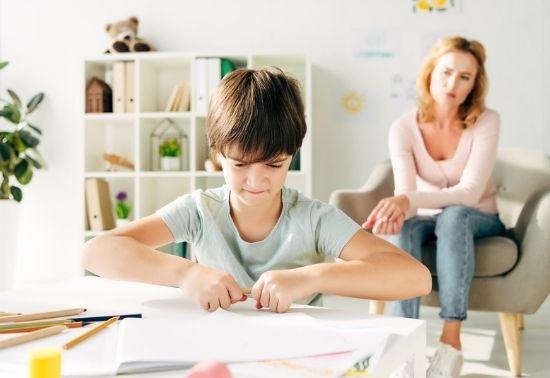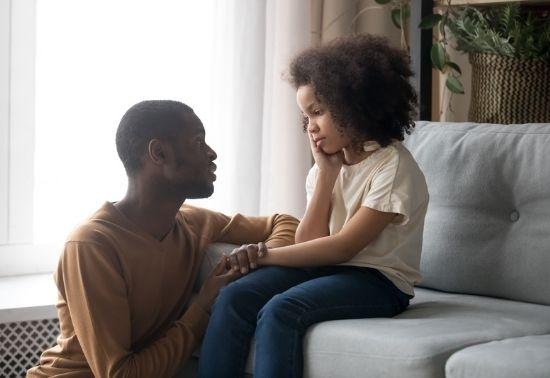Anxiety is one of the most common mental health concerns for children. Worldwide prevalence rates suggest that about 6.5% of children are likely to meet diagnostic criteria for an anxiety disorder at any one time (Polanczyk et al., 2015). Anxiety is the most common presenting concern for children seeking treatment at KIDTHINK. While anxiety is a normal emotion that everyone experiences, for some children it becomes problematic and begins to interfere with their daily functioning, development, and ability to participate in age-appropriate activities. This can lead to significant distress not only for children but for their parents and other family members as well.
Anxiety Treatment
The goal of treating anxiety is not to get rid of the anxiety but to help children manage it so that it does not interfere with their abilities to lead meaningful lives. Anxiety helps us survive. It signals to us when we are in danger, activating our nervous systems and preparing our bodies for action – to fight, flee, or freeze in the face of a real threat or danger. However, some children have overactive alarm systems. They tend to greatly overestimate the amount of risk involved in everyday situations and how terrible the outcomes might be (Clarke & Beck, 2011). They also tend to underestimate their ability to cope with the outcomes and their anxious feelings (Clarke & Beck, 2011). This results in children experiencing a strong sense of helplessness and vulnerability, setting off their fight, flight, or freeze survival responses.
In the face of this distress, children often resort to behaviours that increase their sense of safety and security - mainly AVOIDANCE. The problem with avoidance is that while it is helpful in the short-term in eliminating anxiety, in the long-term, it serves to maintain and reinforce more anxiety because children never get to learn that the risk wasn’t as great as they predicted or that they were, in fact, able to cope (Beck, 2011).
Parents’ natural inclination is to protect their children from distress. Unfortunately, when it comes to anxiety, protecting children from distress by allowing them to avoid anxiety-provoking situations only serves to maintain children’s anxiety and reinforce their avoidance. Exposing children to their fears and anxieties can seem counterintuitive and stressful for parents, but it is doing what’s best for them. Exposure therapy is a large component of the evidence-based cognitive behaviour therapy approach that is considered best practice for treating anxiety in children (AACAP, 2007).
Strategies For Supporting Anxious Children
Settle Yourself First


Parents and caregivers use their own nervous systems to help regulate the nervous systems of their children when their children are upset – whether it’s anxiety or any other distressing emotion like anger or frustration. In the face of heightened emotion in parents, children will have greater difficulty managing anxiety. Parents can settle themselves by taking a moment to tune into themselves and recognize their own reactions to their children’s distress and behaviour - the unhelpful automatic thoughts that pop into their minds (i.e. “Here we go again!”), their feelings (i.e. anxiety, anger, hopelessness), physiological sensations (i.e. muscle tension), and behaviour.
Paying attention to these domains can help parents identify what they need to settle themselves, so they are better able to respond to their children. This may involve taking a few deep breaths, using some coping statements, or taking a brief parent time-out. Developing these skills is hard work and takes practice. It’s important for parents to be gentle with themselves and recognize that they are human and will not get this right 100% of the time.
Validate Feelings


Parents are often activated by their children’s distress. This is what motivates and drives parents to protect their children from danger. Related to this, parents often want to get rid of their children’s anxiety, and this can lead to tendencies to dismiss it or attempts to convince children out of it with statements such as, “Don’t worry,” or, “It will be fine.” Unfortunately, this can have the opposite effect than intended and result in children feeling alone with their anxious feelings, adding to their distress.
Being emotionally present with children in their anxious feelings helps them to feel understood and supports parents in joining with them to begin settling those survival responses. Acknowledging and validating children’s anxious feelings can help parents convey an understanding of how difficult it is for children to face their fears and worries. This can be done without reinforcing children’s anxiety and while communicating confidence in their abilities to cope successfully with situations.
“If you think there are monsters under your bed, no wonder you are feeling scared! It makes sense that you are having such a difficult time falling asleep. Let’s figure out what we can do about this.”
Help children understand the physical symptoms of anxiety


Teaching children about what is happening in their bodies when they are anxious helps them understand that, while the physical sensations are uncomfortable, they are not dangerous. A rapid heartbeat, increased breathing, or muscle tension are signs their bodies are doing just what they were designed to do to help protect them – gathering more oxygen and producing special fuel (cortisol, adrenaline) to give their bodies the energy needed to fight, flee, or freeze. However, because children are not facing life-threatening danger, this is a false alarm and can become problematic.
Instead of viewing physical symptoms of anxiety as threatening, parents and caregivers can praise children for listening to their bodies and help children to view these symptoms as cues to use strategies to help calm their bodies. Relaxation strategies such as belly breathing can be introduced to help children gain a sense of mastery over their bodies as they learn how to settle their survival responses. Developing these skills takes time and effort. Children will often have greater success implementing relaxation skills when they are anxious if they have had plenty of practice using the skills when they are calm and if their parents use them too.
Encourage brave behaviour


Instead of focusing on and giving too much attention to anxious behaviours (i.e. clinging to parents, crying), parents can look for and reinforce the brave behaviours their children exhibit. Brave behaviours include any action or step (no matter how small) children take in moving towards their unrealistic fears. This includes effort – even if children are not successful in completing or following through with the task or step. Providing praise and encouragement for brave behaviour can help children build greater self-confidence and begin to view themselves as brave. This can increase their willingness to face their fears and can help them feel like they have greater control over their anxiety.
Gradual Exposure


Gradual exposure involves helping children face their fears in a gradual way by breaking exposure tasks down into very small and manageable steps. For children who are anxious about swimming lessons, for example, this might involve a progression from showing up to the pool, to sitting next to the water, allowing the instructor to splash some water on their legs, dipping their toes in the water etc. Patience is critical! The most important element is that children are active participants in the process and taking steps to move forward (no matter how small) and are building a sense of mastery and confidence. Pushing children too quickly can overwhelm them, increase their anxiety and set them back in their progress. It’s best for parents to take on a cheerleading role. Celebrating all the small successes and victories is also important and a nice way for parents to reward their children (and themselves!) for all the hard work.
Coping Ahead


Helping children identify their feared outcomes provides an opportunity to help them develop a plan for coping in the event they are faced with their worst-case scenarios. When children can identify ways to solve these problems, they are better prepared to cope, increasing their confidence and willingness to face their fears.
The good news is that anxiety can be treated effectively. It’s helpful to keep in mind, however, that progress will take time and does not happen overnight or in a linear fashion. Setbacks are to be expected and are a natural part of recovery. The goal is not to eliminate anxiety entirely. The aim is to bring anxiety down to manageable levels so that children can lead meaningful and enjoyable lives. We want to help them adjust their alarm systems, so they can experience the helpful effects of anxiety, such as increased alertness and energy before a big test or presentation, without the unhelpful effects of an overactive alarm system that leads to avoidance. Children will need ongoing support to keep practicing skills for some time before they can apply the skills with increasing independence.
For many children, anxiety can be chronic and can resurface at different points in development or when children are faced with unusually large stressors, such as COVID-19. Some children may require additional support from a mental health professional. If anxiety is causing significant impairment in your child’s daily functioning, interfering with his/her ability to participate in developmentally appropriate activities, and/or causing you or your child significant distress, don’t hesitate to seek professional help. Early intervention is best as it leads to better outcomes for children and reduces the likelihood of children suffering from additional mental health concerns.
Kari Deschambault MSW, RSW
Mental Health Clinician


MORE COMMON THAN YOU THINK
- 1 in 7 children suffers from mental illness in Manitoba [6].
- 70% of mental health problems have their onset in childhood or adolescence [4].
There Is Hope The good news is that mental illness can be treated effectively. There are things that can be done to prevent mental illness and its impact and help improve the lives of children experiencing mental health concerns. Early intervention is best.
How KIDTHINK Can Help
To make a referral contact us
To subscribe to our newsletter click here.
References
- American Academy of Child and Adolescent Psychiatry (2007). Practice Parameter of the Assessment and Treatment of Children and Adolescents with Anxiety Disorders. Journal of the American Academy of Child and Adolescent Psychiatry, 46(2), 267-283. Retrieved from https://www.jaacap.org/article/S0890-8567(09)61838-4/pdf.
- Beck, J. (2011). Cognitive Behavior Therapy: Basics and beyond (2nd Ed). Guildford Press: New York.
- Clark, D.A. & Beck, A.T. (2011). Cognitive Therapy of Anxiety Disorders: Science and Practice. Guildford Press: New York.
- Government of Canada. (2006). The human face of mental health and mental illness in Canada. Minister of Public Works and Government Services Canada. Retrieved from https://cpa.ca/docs/File/Practice/human_face_e.pdf
- Polanczyk, G.V., Salum, G.A., Sugaya, L.S., Caye, A., & Rhode, L.A. (2015). Annual Research Review: A meta-analysis of the worldwide prevalence of mental disorders in children and adolescents. Journal of Child Psychology and Psychiatry, 56, 345-365. Retrieved from https://www.researchgate.net/publication/271842422
- Virgo Mental Health and Addictions Strategy Report, Manitoba 2018. Retrieved from https://www.gov.mb.ca/health/mha/strategy.html




